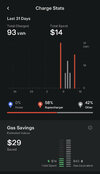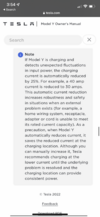Its detecting that the voltage is dropping as current goes up, and it's exceeding some parameter. Possible causes include: a mediocre connection on a daisy-chained outlet string leading to the outlet, too small (probably 14 gauge) wire going to the outlet, or a very long run from the power-panel to the outlet.How come when I charge my car at home using the basic 110V charger it chooses to lower the draw from the max 12 A to 9 A? I was only getting 3 mi/h of charge and it was drawing 9 A. I cranked it back to 12 A. Still, I don't get why it went down to 9 A on it's own.
Check what voltage the car is reporting when it initially gets connected(0 amps, should be around 120V) vs when its ramped up the current to the max(12A, should ideally be no more than 3% less than the initial number). At some loss-level, probably at least a bit above 3%, the car will decide it should try NOT to burn down your house. Keep in mind that the 120V is allowed to waver a good bit(5%, up to 10% for short periods), and if some large load(AC) in your home starts drawing a ton of power, the voltage even for the 120V charger circuit will drop somewhat. The car will potentially notice this and decrease its own charging accordingly.
Last edited:




